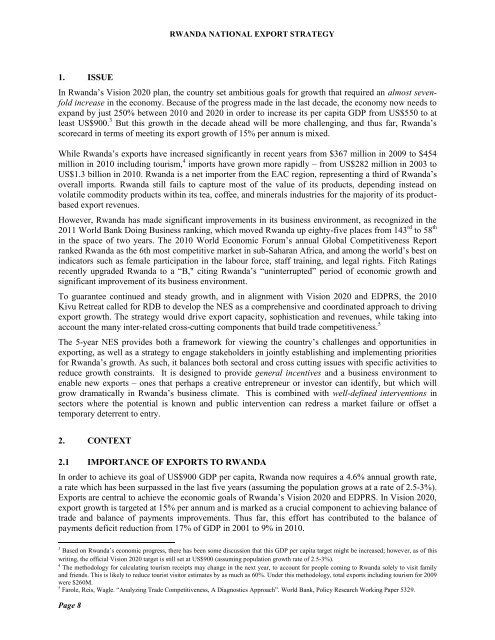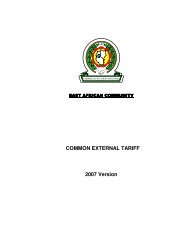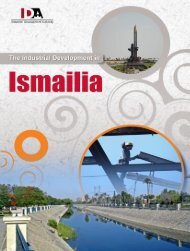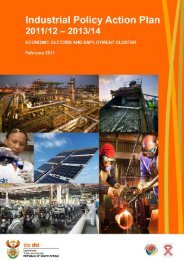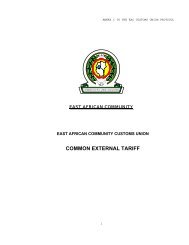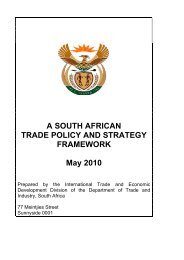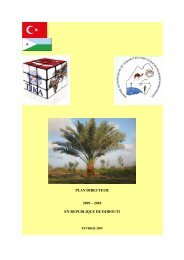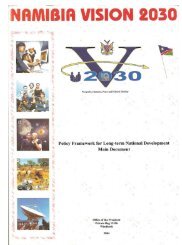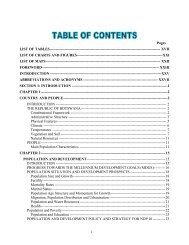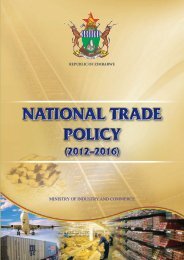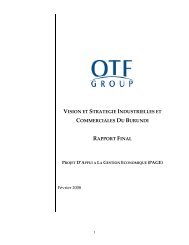rwanda national export strategy - minicom
rwanda national export strategy - minicom
rwanda national export strategy - minicom
You also want an ePaper? Increase the reach of your titles
YUMPU automatically turns print PDFs into web optimized ePapers that Google loves.
RWANDA NATIONAL EXPORT STRATEGY<br />
1. ISSUE<br />
In Rwanda‘s Vision 2020 plan, the country set ambitious goals for growth that required an almost sevenfold<br />
increase in the economy. Because of the progress made in the last decade, the economy now needs to<br />
expand by just 250% between 2010 and 2020 in order to increase its per capita GDP from US$550 to at<br />
least US$900. 3 But this growth in the decade ahead will be more challenging, and thus far, Rwanda‘s<br />
scorecard in terms of meeting its <strong>export</strong> growth of 15% per annum is mixed.<br />
While Rwanda‘s <strong>export</strong>s have increased significantly in recent years from $367 million in 2009 to $454<br />
million in 2010 including tourism, 4 imports have grown more rapidly – from US$282 million in 2003 to<br />
US$1.3 billion in 2010. Rwanda is a net importer from the EAC region, representing a third of Rwanda‘s<br />
overall imports. Rwanda still fails to capture most of the value of its products, depending instead on<br />
volatile commodity products within its tea, coffee, and minerals industries for the majority of its productbased<br />
<strong>export</strong> revenues.<br />
However, Rwanda has made significant improvements in its business environment, as recognized in the<br />
2011 World Bank Doing Business ranking, which moved Rwanda up eighty-five places from 143 rd to 58 th<br />
in the space of two years. The 2010 World Economic Forum‘s annual Global Competitiveness Report<br />
ranked Rwanda as the 6th most competitive market in sub-Saharan Africa, and among the world‘s best on<br />
indicators such as female participation in the labour force, staff training, and legal rights. Fitch Ratings<br />
recently upgraded Rwanda to a ―B," citing Rwanda‘s ―uninterrupted‖ period of economic growth and<br />
significant improvement of its business environment.<br />
To guarantee continued and steady growth, and in alignment with Vision 2020 and EDPRS, the 2010<br />
Kivu Retreat called for RDB to develop the NES as a comprehensive and coordinated approach to driving<br />
<strong>export</strong> growth. The <strong>strategy</strong> would drive <strong>export</strong> capacity, sophistication and revenues, while taking into<br />
account the many inter-related cross-cutting components that build trade competitiveness. 5<br />
The 5-year NES provides both a framework for viewing the country‘s challenges and opportunities in<br />
<strong>export</strong>ing, as well as a <strong>strategy</strong> to engage stakeholders in jointly establishing and implementing priorities<br />
for Rwanda‘s growth. As such, it balances both sectoral and cross cutting issues with specific activities to<br />
reduce growth constraints. It is designed to provide general incentives and a business environment to<br />
enable new <strong>export</strong>s – ones that perhaps a creative entrepreneur or investor can identify, but which will<br />
grow dramatically in Rwanda‘s business climate. This is combined with well-defined interventions in<br />
sectors where the potential is known and public intervention can redress a market failure or offset a<br />
temporary deterrent to entry.<br />
2. CONTEXT<br />
2.1 IMPORTANCE OF EXPORTS TO RWANDA<br />
In order to achieve its goal of US$900 GDP per capita, Rwanda now requires a 4.6% annual growth rate,<br />
a rate which has been surpassed in the last five years (assuming the population grows at a rate of 2.5-3%).<br />
Exports are central to achieve the economic goals of Rwanda‘s Vision 2020 and EDPRS. In Vision 2020,<br />
<strong>export</strong> growth is targeted at 15% per annum and is marked as a crucial component to achieving balance of<br />
trade and balance of payments improvements. Thus far, this effort has contributed to the balance of<br />
payments deficit reduction from 17% of GDP in 2001 to 9% in 2010.<br />
3 Based on Rwanda‘s economic progress, there has been some discussion that this GDP per capita target might be increased; however, as of this<br />
writing, the official Vision 2020 target is still set at US$900 (assuming population growth rate of 2.5-3%).<br />
4 The methodology for calculating tourism receipts may change in the next year, to account for people coming to Rwanda solely to visit family<br />
and friends. This is likely to reduce tourist visitor estimates by as much as 60%. Under this methodology, total <strong>export</strong>s including tourism for 2009<br />
were $260M.<br />
5 Farole, Reis, Wagle. ―Analyzing Trade Competitiveness, A Diagnostics Approach‖. World Bank, Policy Research Working Paper 5329.<br />
Page 8


